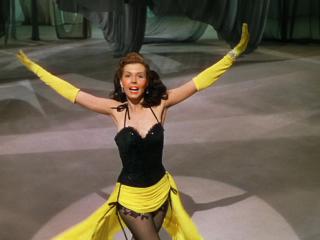The Siren has been contemplating fashions in actors. I'm sure you have noticed how some players command a following to this day, and others go in cycles. To touch on one actress with a huge following, as recently as the 1980s there weren't that many Audrey Hepburn fans around. Now I am, I confess, getting a little tired of hearing about that lovely woman from people who consider the relatively weak and wildly uneven
Breakfast at Tiffany's to be her finest hour. (
I don't think so.)
Meanwhile, other fine actors have only a fan site or two and maybe a TCM Star of the Month tribute to keep them going. This week, the Siren starts a occasional series of nominations for Stars Who Deserve a Revival, Damn It. I assume that serious cinephiles already know these performers, so by revival, I mean a broader profile with the general public. A full-length biography that makes it to paperback, for example, or a postcard set sold by the Barnes & Noble cash register. A coffee-table book or one of those DVD boxed sets Amazon always emails me about. In fact, let's use the DVD boxed set as a yardstick.
I am starting with a doozy, the great Miriam Hopkins. Hopkins's fame rests today at least in part on a role she didn't get, that of Scarlett O'Hara. She tested for it and wanted it badly. No one could wish anyone other than Vivien Leigh in the role, but I think Hopkins might not have been half bad. No matter. She didn't need to play Scarlett. She WAS Scarlett. From her Georgia roots (like Scarlett, Miriam's connections to Old South aristocracy were on her mother's side), to her string of men, to her foot-stomping, crockery-throwing temper, Hopkins lived the part.
She wasn't a classic beauty, but she had what the Siren calls an actressy face, able to look seductively gorgeous for one film, achingly plain in another. (Cate Blanchett has this same quality today.) She was tiny, about 5'2" and 102 pounds, and it's possible her notorious scene-stealing had to do with a petite person's fear of disappearing. Co-stars like Bette Davis just said she was a bitch.
Whatever the reason, there was no trick Miriam wouldn't pull if she thought she could get away with it. Even Kay Francis, one of Miriam's few Hollywood friends, didn't escape. For a scene with Miriam in
Trouble in Paradise, Francis told of having to eat more than twenty boiled eggs before Ernst Lubitsch himself could get a shot with her face toward the camera. When you see the movie scene, and realize Kay is having breakfast in bed and Miriam is
sitting beside her, you appreciate how dedicated Miriam must have been to the art of upstaging. Other co-stars fared no better. Edward G. Robinson detested the actress, and in his autobiography he gleefully described filming a scene in
Barbary Coast in which he slapped her. (The set burst into applause.) Davis told a similar story about a slap scene in
Old Acquaintance. Davis also claimed that in
The Old Maid Miriam almost inched her costar off a couch while trying to get a better camera angle.
With tales of such behavior circulating, it isn't surprising that Hopkins' career blazed up very briefly, and sputtered out later in a series of stage and character roles. But it's still a pity. Miriam was gifted. Lubitsch said she was the best actress he ever worked with. Mamoulian considered her a trouper.
Here, then, is the Siren's list of DVDs she'd include in that boxed set:
1. Dr. Jekyll and Mr. Hyde (1931). The Rouben Mamoulian film that put Miriam on the map. She didn't want to play Ivy, the dance-hall tart. She wanted to play Muriel, the colorless fiancee who isn't even in the original novel. But the director talked her into it by telling her fine, play Muriel--"but Ivy would have made you a star." Hopkins started to leave, then came back and asked to play Ivy. For once her mercurial nature led her to a great decision. She would never be sexier than she was rocking a leg back and forth in front of Fredric March.
2. Trouble in Paradise (1932). This one, by common consent Miriam's best movie, is available in a beautiful DVD from the Criterion Collection. Miriam plays Lily Vautier, a thief who hooks up with the equally light-fingered Herbert Marshall. Together they try to rob wealthy Kay Francis, but Marshall finds himself unexpectedly drawn to his mark.
This is a romantic triangle plot, but when she watches this one the Siren roots for Miriam all the way. How could she not? The early scene where Hopkins and Marshall recognize that they've both been trying to rob each other blind is one of the Siren's favorites in any comedy. It begins with Miriam drooping around the hotel room and emoting in a manner familiar to anyone who's ever sat through a Norma Shearer vehicle: "Oh, one gets so tired of one's own class--princes and counts and dukes and kings! Everybody talking shop." As they wise up to each other, Marshall shakes her, and out falls a man's wallet. "I knew it very well when you took it out of my pocket," he tells her. "In fact, you tickled me. But your embrace was so sweet." He returns the brooch he lifted from smack in the middle of her décolletage. Hopkins counters by graciously handing him his watch, adding "It was five minutes slow but I regulated it for you." Marshall regains his composure and says, "I hope you don't mind if I keep your garter." Hopkins reaches down to feel for the item, Marshall produces it with a flourish, and Hopkins flings herself into his arms with a cry of "Darling!"
Now that, says the Siren, is true love.
3. Design for Living (1933). Lubitsch again. Miriam plays Gilda, a woman who can't decide between Fredric March and Gary Cooper. Her accomplishment here is to make Gilda thoroughly believable and likable, despite her hopping from March to Cooper and back again and making a fine mess. Miriam's great all the way through, but her best work comes at the end. Her martyred expression when asking "Is it animal, vegetable or mineral?" as part of a game with some hopelessly dull clients is something to treasure. But the best scene is Hopkins losing her temper with Edward Everett Horton. "I forgive you," he says. "Are you forgiving me again?" she snaps back, adding later, "I'm sick of being a trademark married to a slogan!"
4. Becky Sharp (1935). Famous for being the first full-length feature in three-strip Technicolor, and for not much else. It deserves another look. The film is static, probably due to the demands of the new technique. It's reminiscent of early talkies, with one medium shot after another, and the supporting cast isn't exactly mesmerizing, for the most part. But the Siren loves Hopkins as Becky. There wasn't another actress who could have captured the character's grasping-yet-generous nature. Mamoulian's film compresses William Makepeace Thackeray's humongous novel into less than 90 minutes, and does so intelligibly, even managing to save some of the novelist's wit. The screenwriters also jettisoned the novel's one major flaw, Thackeray's pompous, moralizing take on Becky's fate.
5. These Three (1936). Miriam plays the goodhearted victim here, a rarity for her.
These Three is an adaptation of Lillian Hellman's lesbian-themed play
The Children's Hour, so scandalous at the time that even the title couldn't be retained. Miriam and the ever-ravishing Merle Oberon play teachers who become the target of a vicious, spoiled young girl, played by a delectably spiteful Bonita Granville. (Granville made something of a career of this type of role, later tormenting Bette Davis with thoughtless jokes in
Now, Voyager.) In the play the girl accuses the teachers of being lovers; in the movie, she lies about the relationship between Oberon's fiance, played by Joel McCrea, and Hopkins. Miriam does a lovely job portraying her character's slow, agonizing realization that she does, in truth, love McCrea.
6. The Old Maid (1939). This potentially sudsy story of love delayed and denied rises to the level of art through a literate script and unforgettable performances. Miriam plays Bette Davis's bitchy, vengeful--but, in the end, far from heartless--friend. Davis told costumer Orry-Kelly before filming that Hopkins "will be trouble, but she'll be worth it." They hated each other all right, but Bette's scenes with Miriam are some of the best either actress ever put on film. There are critics, such as Lawrence Quirk, who consider this Davis's finest performance. The Siren says actors feed off what they get from one another in a scene, and Davis wouldn't have been as great with a lesser actress in the Hopkins role.
Miriam's film career went into sad decline after the 1930s, despite a few bright spots (
Old Acquaintance (1943) and a nice turn in
The Heiress (1949) among them). She found work on the stage, but as years passed the parts got weaker and the venues got smaller. One ill-fated onstage role was the main character in an early and dismally short-lived version of
Orpheus Descending. When Miriam died in 1972 Tennessee Williams wrote, "I know that Paramount Pictures must be aware of her value, the value of her unique talent and personality, and I trust that there will be continued r[ev]ivals of her films...she has the quality of which a 'cult' could emerge." The Siren hopes time eventually proves him right.
Note: Information about Miriam isn't easy to find, and despite a fascinating life she has never had a full-length biography. The Siren drew most of her facts from George Eells's essay "The Maverick," in his Ginger, Loretta and Irene Who?
, Putnam 1976. There's an intelligent and detailed fan site here. Also, if you are wondering why the Siren didn't mention The Smiling Lieutenant
, it's because she hasn't seen it.






